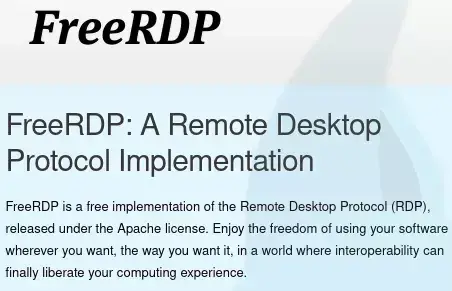- cross-posted to:
- opensource@lemmy.helvetet.eu
- cross-posted to:
- opensource@lemmy.helvetet.eu
This is the best summary I could come up with:
FreeRDP 3.0 continues getting better for this open-source solution for interoperability with Microsoft RDP for remote desktop purposes.
Released at the end of July was the FreeRDP 3.0 beta for this open-source Remote Desktop Protocol (RDP) implementation.
FreeRDP 3.0 is bringing AAD/AVD authentication, WebSocket Transport, SmartCard emulation support, OpenSSL 3 support, a new reference client based on SDL2, and a wide array of other improvements for this remote desktop/GUI handling solution for interoperability with Microsoft’s RDP on Windows.
With today’s FreeRDP 3.0 Beta 2 release there is improved AAD support, improved HTTP gateway failure logging, improved shadow server error handling, CMake build system enhancements, the SDL client now has basic multi-monitor support, improved MinGW build support, and various other enhancements.
Downloads and more details on the FreeRDP 3.0 Beta 2 release via GitHub.
I’m a bot and I’m open source!

I’ve been using it through remmina for years at this point and I’ve rarely had a problem with it. Big thank you to the developers
Same. Except I use krdc. There’s a weird bug where sometimes it stops accepting input at random. Hoping this release has a fix.

So I can install this on a Windows Home PC and access it through Linux? I couldn’t find any clear info on this.

Freerdp is a client not the server. As far as I know for windows you’d need to use something like no machine or teamviewer for that kind of functionality (or upgrade to pro for the rdp function)

@socphoenix @On RDP server and client is Microsoft built-in, but bound to license restrictions. In general, 2 concurrent rdp sessions on one machine are possible without a need to extend the standard Windows license / price. You can add and license the rdp services role / terminalserver role to a machine setup and have more flexibility: more users, more administration of user sessions.
If your target is a Windows machine, you need a user that is a member of the target machine’s local rdp or local admin security group, either directly or via a domain security group, start a client software (below) depending on your machine’s operating system, enter the target machine’s address (ip or name) and user name and password, and have a desktop session on the target machine in a window to remote comtrol it. You might need a VPN or citrix connection to the target’s domain and you might need to qualify a user domain of your login credentials, but that’s it in general.
1/x

@socphoenix @On If the machine you are working at is on
* Windows: You can use Windows built-in RDP client mstsc.exe. There are alternatives and wrappers. I found that using mstsc.exe through RDP+ (https://donkz.nl) is the most reliable, comfortable, and safely automatable solution.
* Linux: You need a client software. I use Remmina (often in your distribution’s standard repository) for that purpose. I understand from FreeRDP’s linked and the github pages that FreeRDP is a concurrent client. It’s tagged »Android« too. I usually need to work on the target and wouldn’t torture myself with a mini and touch screen for RDP, so I personally don’t mind.
You always need to try which client software works best in your situation and setup. So testing if FreeRDP is a client, and if for your operating system, can be done on the run.
2/x

@socphoenix @On You have other possibilities with Windows targets for remote control. You could set up the Windows built-in OpenSSH or another SSH server on the target, use Kitty SSH client, and tunnel RDP through SSH tunnel. Use FreeTube or NewPipe to find tutorial clips for that. If only classic SSH on the command line is possible, I’d prefer PowerShell remoting, if your client is on Windows too.
You wouldn’t usually bother to implement RDP services with Linux targets, if not forced to by policies.
In summary, Microsoft RDP can be easiest, because built-in. Can be obligatory. There are prequisites: access to the target’s domain (VPN, SSH, Citrix, …), entitled user credentials, client software, knowledge of target’s internal address / hostname.
3/4

@socphoenix @On If nothing with RDP necessary or possible: https://rustdesk.com/ is the easiest and recommended, it’s much like Teamviewer but free. (Free as in FLOSS, and free of charge as well.) It works with most operating system combinations. Technically, it has nothing to do with the concurrent protocols / standards Microsoft RDP, Teamviewer, SSH, …

The rdp client (at least in 10/11, I haven’t tried others) tells me I need at least pro instead of home to use it, thus my comment about upgrading windows. Thank you for the extra clarification for those that can use it though!

RDPWrap used to be able to run a patched version of RDP for Windows Home to enable incoming RDP but it isn’t maintained anymore. You didn’t need to upgrade to Pro.
To access Linux from Windows, you need to install xrdp in Linux, if using Ubuntu there was some install problem and a guy made a script to properly install it.
To access windows from Linux, use remmina in Linux, it works pretty well I’m using it daily. Remmina can use a lot of remote protocol, FreeRDP is one of them.



